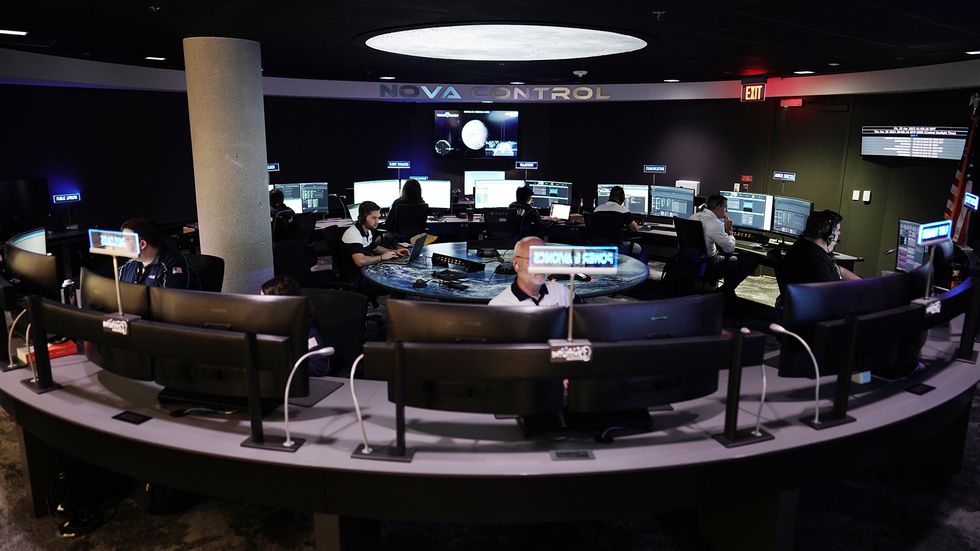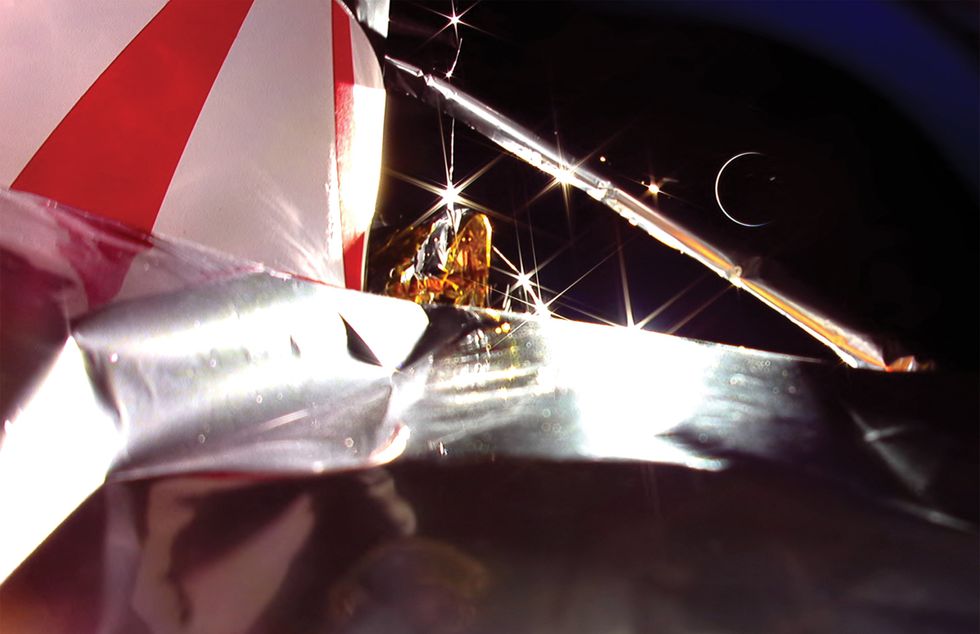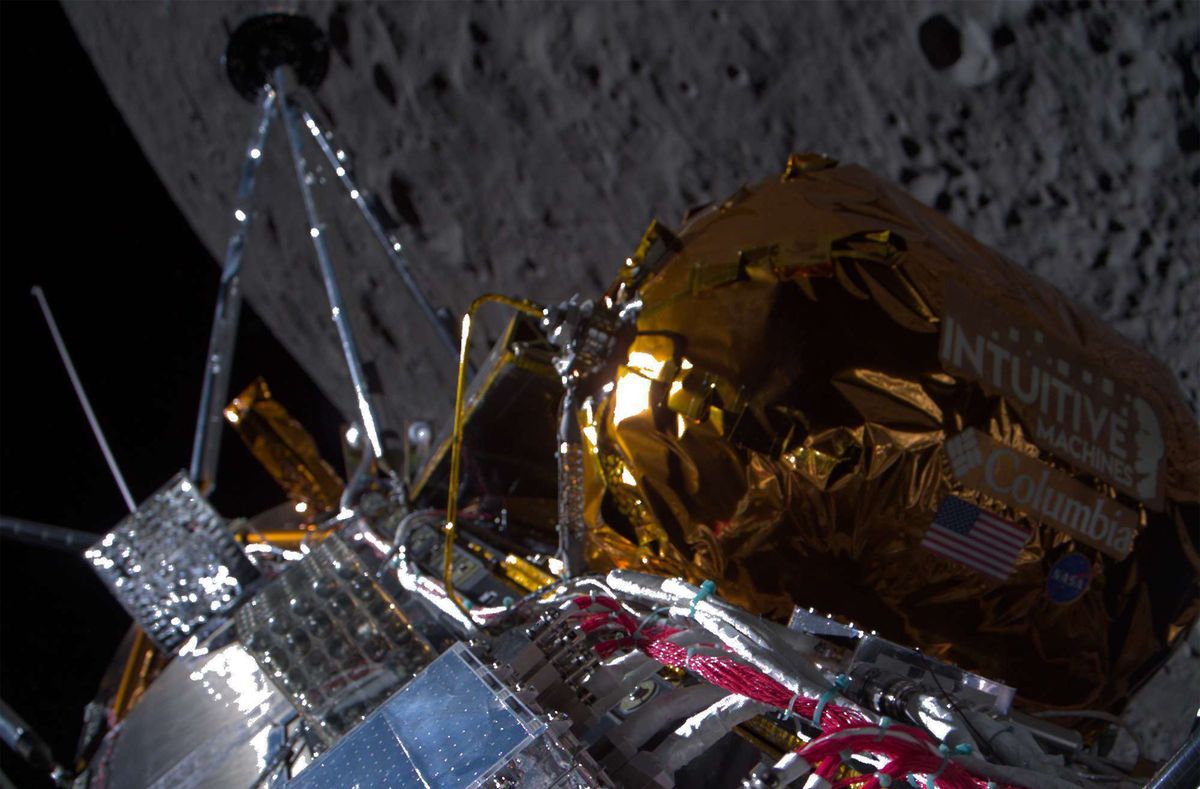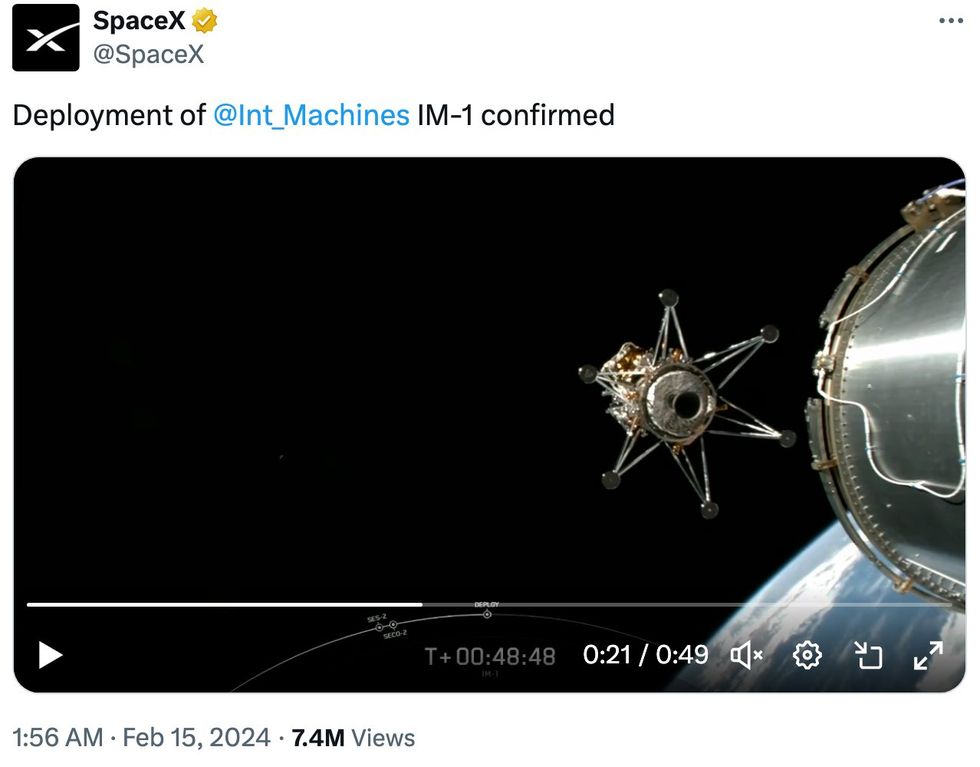UPDATE 23 Feb. 2024: Descending on a jet of burning methane, kicking up dust in all directions, Intuitive Machines’ robotic spacecraft Odysseus came to rest on the moon Thursday. And then, for 15 tense minutes, controllers waited for a sign that the ship was safe and working. Finally, buoyed by reception of a weak radio signal, mission director Tim Crain came on a communications loop and said, “We can confirm without a doubt that our equipment is on the surface of the moon.”
A few minutes later: “Odysseus found its new home.”
It was the first American ship to land on the moon since the astronauts of Apollo 17 in 1972. It was the first ever by a private company. And, apparently, it was a close call. Controllers realized, with just hours to go before landing, that downward-facing cameras and lidar to guide the ship’s approach were offline. With the clock ticking, they wrote and sent a software patch, telling the guidance system to use other downward-facing sensors, originally meant for an experiment to improve the precision of future landings—just not this one. —IEEE Spectrum
Story from 15 Feb. 2024 continues:
It was just past 1 a.m. Eastern Time this morning when a SpaceX rocket lit up the Florida sky, carrying Intuitive Machines IM-1 toward the moon. The launch, according to the two companies, was flawless.
“Go, SpaceX, go IM-1 and the Odysseus lunar lander,” said a voice on the communications loop. Forty-eight minutes later, a camera showed the spacecraft separating safely from its booster and heading off into the black.
Engineers at Houston-based Intuitive Machines named their moonship after the hero-wanderer of Greek mythology. The company designed its control room in Houston to resemble the bridge of the starship Enterprise from Star Trek. Give this much to Intuitive Machines—they have dramatic flair. The private spacefaring company now aims for a landing on 22 February, just 300 kilometers from the lunar south pole.
All of history’s lunar landings, dating back to the 1960s, have been organized by government agencies.
But, then, notice too that one of the largest logos on the lander’s side is that of Columbia Sportswear. The activewear company did make insulating material for the flight. But other than that, need it be noted, their brand is not exactly synonymous with space exploration. Odysseus is a commercial mission, and if it succeeds, history will remember it as the first lunar landing made by a private company.
Odysseus begins its journey
The six-legged robotic lander, which Intuitive likens in size to an old-fashioned British telephone booth, is 4.3 meters tall with a hexagonal hull 1.6 meters in diameter. The company initially called this inaugural flight IM-1, using a lander design it calls Nova-C. Propulsion comes from liquid methane and liquid oxygen, cryogenic fuels that need well-insulated tanks but are lighter and less corrosive than the propellants used by most spacecraft in flight. NASA has taken a relatively hands-off approach to the mission; it’s part of the agency’s CLPS program—short for Commercial Lunar Payload Services. The agency’s mantra for years has been to let private companies run the actual missions, with NASA as a paying customer. It can mean major cost savings for the government; it’s up to the companies to cover their bills.
To that end, Intuitive Machines offered to carry payloads for profit. It carries a hodgepodge—12 in all, six paid for by NASA. Many are serious science, such as NASA experiments on the behavior of lunar dust as the ship lands. Some are more fanciful, such as an array of steel moon sculptures by the artist Jeff Koons.
“We learn lessons from all of our counterparts that have come before us, partners in advancing lunar exploration.” —Trent Martin, Intuitive Machines
And one is—well, maybe very cool. Intuitive’s CEO, Steve Altemus, asked students and faculty at his alma mater, Embry-Riddle Aeronautical University, to build EagleCam, a 5-kilogram camera that, if all goes well, will pop out of the side of the ship as it descends, 10 meters above the lunar surface, imaging the landing as it happens. It may provide vital data about the flight, or, as the company puts it, “the world’s ultimate selfie.”

Private enterprise has become a hot thing in space—just look at the weekly satellite launches by SpaceX—but not when it comes to landing on the moon. All of history’s lunar landings, dating back to the 1960s, have been organized by government agencies; companies that tried are, so far, batting zero. A probe called Beresheet, made by an Israeli company called SpaceIL, failed in 2019. A Japanese company, ispace, lost its Hakuto-R lander in 2023. Both crashed on final approach, perhaps done in by software errors.
The failed lunar landing attempts
The most recent attempt, in January, was by Astrobotic Technology, a Pittsburgh-based company that built a lander called Peregrine. Almost all of Peregrine’s systems worked perfectly, according to Astrobotic, except for something—perhaps a helium valve that wouldn’t close properly—that crippled its propulsion system. The spacecraft traced a long ellipse, reaching lunar distance but then falling back to Earth and burning up on reentry over the Pacific Ocean.

The people who ran these missions were certainly tenacious. Though they’d all lost years of work, each company said it would press forward with follow-up flights.
But how much can the engineers of Odysseus learn from others’ setbacks? Not that much, actually.
“We did not achieve the primary objective of landing on the surface of the moon,” said Astrobotic’s CEO, John Thornton, “but after that anomaly we just had victory after victory after victory, showing the spacecraft was working in space.”
But how much can the engineers of Odysseus learn from others’ setbacks? Not that much, actually. A NASA project may be expensive and slow, but it’s also obliged to be open. Privately run missions have the opposite incentive, to keep their data to themselves. They are competitive efforts, with their own intellectual property, and profits or losses that depend on how many milestones they reach on their way to a hoped-for landing. Intuitive and Astrobotic both confirmed to Spectrum that they are not in contact with each other.
The government stays clear of all this. “NASA does not share proprietary information from one company to another company,” said Joel Kearns, deputy associate director of NASA’s Science Mission Directorate, after Peregrine’s end. “But of course we will take the lessons from this in our thinking on CLPS and we’ll encourage Astrobotic to share the findings with other companies.”
So Odysseus, like its namesake, is on a long, lonely voyage, hoping to break the streak and be the first to reach its destination safely.
“We learn lessons from all of our counterparts that have come before us, partners in advancing lunar exploration,” said Trent Martin, a vice president at Intuitive Machines, at a media briefing before launch. “We looked at the failures that they’ve had. We look at our systems to ensure that we’ve at least thought about those issues, thought about what the failure was, ensure that we hopefully will not suffer the same failures that they did.”
- Chandrayaan-3 Moon Landing: Win for a “New India” ›
- The Many Planned Moon Landings of 2023 ›
- NASA Is Working With Blue Origin on a Lunar Lander - IEEE Spectrum ›
Ned Potter is a New York writer who spent more than 25 years as an ABC News and CBS News correspondent covering science, technology, space, and the environment.




